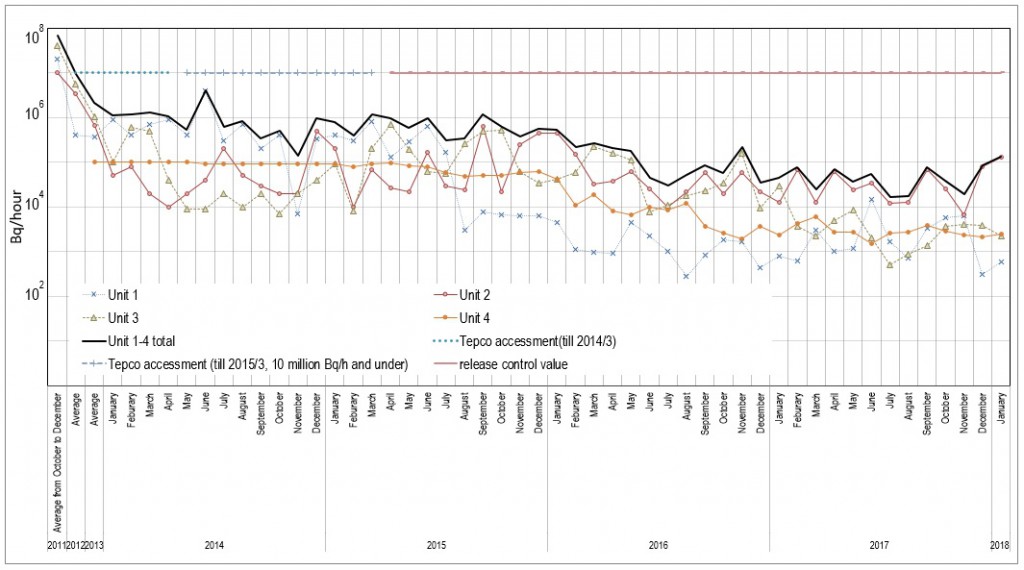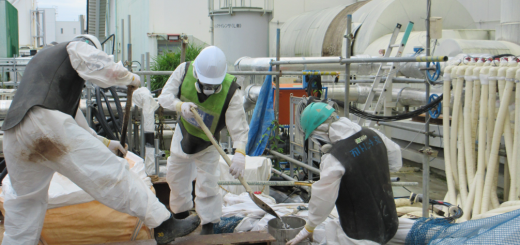Fukushima Now Part 2: Current State of Post-Accident Operations at Fukushima Daiichi Nuclear Power Station (July to December 2017)
From the water temperature in the containment vessels and the spent fuel pools (SFPs), and from the state of releases of Xenon-135, released when uranium fuel undergoes fission, and other measurements, it can be estimated that the state of the reactors is stable. Further, according to an assessment by TEPCO, around 87,000 bequerels per hour (Bq/h) of radioactive materials were being released from the buildings as of December 2017 (See Fig.1).
Contaminated water countermeasures at Fukushima Daiichi Nuclear Power Station (FDNPS) can be broadly divided into three areas: 1) Reduction of groundwater flowing into buildings, 2) Reduction of contaminated water flowing into the sea, and 3) Reduction of the toxicity of contaminated water.
Regarding the reduction of water volumes flowing into buildings, the main countermeasures are, from higher elevations downward, A) Pumping up groundwater at the ground water bypass and releasing it into the sea (331.310m3 up to November 27), B) Installation of a frozen earth barrier (on-land water barrier, total length roughly 1,500m) surrounding FDNPS Units 1-4. (Closure of the remaining unfrozen section of 7m was begun on August 22 and completed on November 3.) C) Pumping up water at the subdrains and releasing it into the sea (460,076m3 up to November 27), and D) Paving of the site with asphalt to suppress permeation of rainwater into the soil.
Regarding reduction of contaminated water flowing into the sea, the countermeasures being taken include A) Groundwater leakage prevention by a steel water barrier on the sea side, B) Pumping up of groundwater dammed up behind the sea-side water barrier from the well points and groundwater drains. (164.000m3 up to November 28; as this groundwater is highly contaminated, it is being transferred to the turbine building), and C) Countermeasures against leaks in the tank areas, where contaminated water is being stored.
Due to these countermeasures, volumes of groundwater flowing into buildings has been reduced from an original 400m3/day to 140m3/day (average volumes from December 2012 to January 2018, including volumes transferred). According to the medium to long-term road map revised in June 2015, the volume of water flowing into buildings was to be suppressed to 100m3/day or less in FY2016, but as the current medium- to long-term road map calls for suppression of the contaminated water volume to be around 150m3/day during FY2020, it can be said that the goal has been attained. However, there are still various doubts about the effectiveness of the frozen earth barrier.
Regarding the reduction of the toxicity of contaminated water, measures taken at present are mainly A) Removal of cesium and strontium from contaminated water in buildings using cesium adsorption devices, and B) Treatment of contaminated water already treated by the cesium adsorption devices in ALPS (Advanced Liquid Processing System). The contaminated water storage situation is ALPS-treated water: 842,715m3, water treated by cesium adsorption devices, etc.: 188,751m3, water treated by reverse osmosis (RO): 12,663m3, concentrated brine: 700m3, Units 5 & 6 tanks: 15,618m3, water stored in buildings: 56,037m3, and other contaminated water: 21,621m3.
As of December 14, 921 tanks had been installed on the site (of which 154 are flange-type tanks) and TEPCO plans to have a total capacity of 1.37 million m3 installed by 2020. However, as the upper limit of storage capacity will be reached around 2023-2024 if additional volumes of contaminated water continue to increase at the current rate, it is said that further installment of tanks will require the removal of existing buildings.
TEPCO, the government and the Nuclear Regulation Authority (NRA) are calling water treated by ALPS ‘tritium water’. Nuclides remaining in contaminated water after ALPS treatment are summarized in Table 2. While TEPCO stated in July 2017 that it had finalized the decision to release the tritium-contaminated water into the ocean after diluting it with seawater to below the notification concentration (60,000 bequerels/liter), when faced with local opposition the company later said that it had not reached a final decision. The Agency for Natural Resources and Energy set up a task force on tritium-contaminated water to consider five types of disposal methods, stratum injection, ocean release, steam release, hydrogen discharge, and subsurface burial. On this basis, a subcommittee on the handling of water treated by ALPS is now considering the matter.
At the same time, NRA is actively pushing dilution disposal. Attempting to compel local people to accept TEPCO’s decision, Chairperson Toyoshi Fuketa stated in a meeting with Iitate Village Mayor Norio Sugano in December that “there is no other option but to dilute [the tritium-contaminated water] and release it into the ocean.”
However, with the Citizens’ Commission on Nuclear Energy (CCNE) advocating storage of the tritium-contaminated water in 100,000-ton oil storage tanks as an example, it is not as if there were no other options available. The pushing forward of one option by the regulatory authority, thereby exceeding its mandate, is an extremely grave issue when seen from the viewpoint of the neutrality of regulatory work.
On-site waste materials can be broadly categorized into three types. These are solid radioactive waste substances that were generated before the accident, solid radioactive waste materials such as debris that were generated after the accident, and secondary waste generated by contaminated water treatment.
The volumes of waste materials generated after the accident, as of December, were concrete and metal debris: roughly 224,200m3 (% occupancy ratio (similarly below): 69%), felled trees: roughly 133,700m3 (72%), protective clothing: roughly 59.900m3 (84%), waste sludge: 597m3 (85%), discharged concentrated liquids: 9,319m3 (87%), and spent vessels and ALPS waste packed in high integrity containers (HIC), etc.: 3,865 containers (61%).


